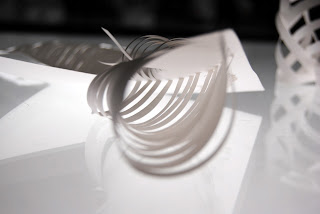He believes that his work is just the exploration of the actually paper, what it can provide him, he doesn't think of it's restriction, he simply lets the paper do the work for him, he just knows where to slice, score and cut.
His work ranges from voluptuous organic curves to industrial straight edges, a very diverse collection which requires great craftmanship and patience (which I do't have very much of...) so this project will certainly be a challenge. It seem that a lot of his work is based on fractal geometry, however he stated in the workshop, 'that he hated maths and is terrible at it...' But, in his work you can see the acute, obtuse and reflex angles. You can see the Fermat spirals developing as he repeats his work.
You can almost say he creates work which are recreations of plants such as wheat, pollen from flowers, coral from the sea. (Well, that how I interpret his work..)
W/O/R/K/S/H/O/P
Basically... You had...
- Scalpel
- A5 sheet of paper
- Your hands
- Your brain
NO ADHESIVES
NO CELLO TAPE
ONLY ONE SHEET OF PAPER
otherwise there were NO restrictions....
Trying techniques which you could change this flat 2- dimensional into an abstract, representational 3D form.
I experimented with techniques such as ripping the paper, slicing into the paper alternating the with intervals of slicing, simply scoring into the paper, creating a crease for the paper so it can bend. Then learning technique of joining the paper without adhesives. Tabs, slots, plaiting the paper seems to be the most sucessful methods.
My first creation...
I have gone for the organic, intricate and curvaceous approach.... slicing the paper in thin strips and creating slots so I can fold it back on itself creating the curved shapes. I was specifically trying to achieve a shape related to nature but it could be interpreted as the skeletal body of a small mammal. I like the idea of intricacy and would like to explore it further, developing my pieces further. However to make sure that you can also realise the craftmanship involved with the photographs that I am going to take. I have to consider whether the photograph captures it's true scale or implies that it is larger than it actually is...






No comments:
Post a Comment